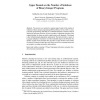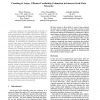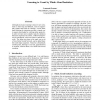1289 search results - page 6 / 258 » Complexity of Counting the Optimal Solutions |
CPAIOR
2010
Springer
14 years 2 months ago
2010
Springer
We present a new method to compute upper bounds of the number of solutions of binary integer programming (BIP) problems. Given a BIP, we create a dynamic programming (DP) table for...
MP
2010
13 years 4 months ago
2010
Given a generic semidefinite program, specified by matrices with rational entries, each coordinate of its optimal solution is an algebraic number. We study the degree of the minima...
TCS
2008
13 years 9 months ago
2008
Finding, counting and/or listing triangles (three vertices with three edges) in massive graphs are natural fundamental problems, which received recently much attention because of ...
ICDE
2006
IEEE
14 years 11 months ago
2006
IEEE
Counting in general, and estimating the cardinality of (multi-) sets in particular, is highly desirable for a large variety of applications, representing a foundational block for ...
IJCAI
2007
13 years 11 months ago
2007
Although necessary, learning to discover new solutions is often long and difficult, even for supposedly simple tasks such as counting. On the other hand, learning by imitation pr...



